 |
| More Info:Technical Specs & Tests Platforms: Legacy eCommerce, KCCP eCommerce and eCommerce+OMS |
PayPal is one of the world's largest digital payment processors, serving over 169 million customers in more than 200 markets. The PayPal Express application enables you to easily add PayPal's Express Checkout functionality to your existing eCommerce payment options.
Application Features
- Enables PayPal Express Checkout on both shopping cart and checkout pages. Customers with a PayPal account can check out directly from the cart.
- Securely connects Kibo to your existing PayPal merchant account through your PayPal Merchant ID and API Signature.
- Communicates necessary order and shipping information between both systems.
- Allows for separate authorization and capture. Authorize payments on customer order and capture later through eCommerce.
- Imports all necessary order information back into eCommerce for payment capture, fulfillment, and order history.
- Can be enabled alongside any other payment providers or gateways, including Pay with Amazon and Visa Checkout.
Setup Overview
The following steps are required before you can use PayPal Express Checkout on your site(s):
- Install the PayPal Express Application on your tenant.
If you create a new site in a tenant after installing the PayPal Express Application, you must reinstall the app to apply the payment configuration settings to the new site.
- Update your Kibo theme.
- Configure PayPal Express in your payment settings.
- Enable the app.
Install the App
Kibo offers two options for adding PayPal Express Checkout functionality to your tenant:
- (Recommended) Contact your SI partner or Kibo's professional services and enablement team to install the PayPal Express Application on your tenant.
- Build the application from the Kibo-provided code on GitHub and install it to Dev Center. This option requires that you have API Extensions enabled on your tenant, and is only recommended if you are working with Kibo Professional Services or a Kibo Partner and need a highly customized integration. Contact your sales or professional services representative for more information.
If you create a new site in a tenant after installing the PayPal Express Application, you must reinstall the app to apply the payment configuration settings to the new site.
Update Your Kibo eCommerce Theme
Installing and configuring the PayPal Express app enables PayPal Express functionality in Admin. However, you still must enable PayPal functionality on your storefront so that customers can use it. Kibo provides a couple sample themes on GitHub that you can use to integrate PayPal Express functionality:
- Select your sample theme:
- PayPalExpress-Theme—Contains the full source files for the Kibo Core 9 theme, with the required changes to enable PayPal Express. Branches of this theme are also available for Core 8, 7, and 6.
- ThirdpartyPayments-Theme—Contains the full source files for the Kibo Core 9 theme, with the required changes to enable both PayPal Express and Pay with Amazon. Use this theme if you are enabling both payment options at the same time. A branch of this theme is also available for Core 8. Note that Pay with Amazon requires the installation of a separate app.
- Review and apply the changes made in our sample implementation to your own theme. You can run the
git diffcommand in any command-line shell to see the differences between the sample implementation and your own theme. - Use the Kibo Theme Generator or run Grunt to build the theme.
- Upload the resulting ZIP file to Dev Center.
- Install the updated theme to the sandbox you're working in.
- In Admin, go to Main > Content > Themes.
- Click the dots next to the new theme and select Apply.
Configure the App
After the PayPal Express application is installed, you must configure your payment settings in Admin to connect eCommerce with your PayPal account:
If you create a new site in a tenant that already has the PayPal Express Application installed, you must reinstall the app to apply the payment configuration settings to the new site.
- In Admin, go to System > Settings > Payments.
- Check the PayPalExpress2 checkbox to display the PayPal configuration fields:
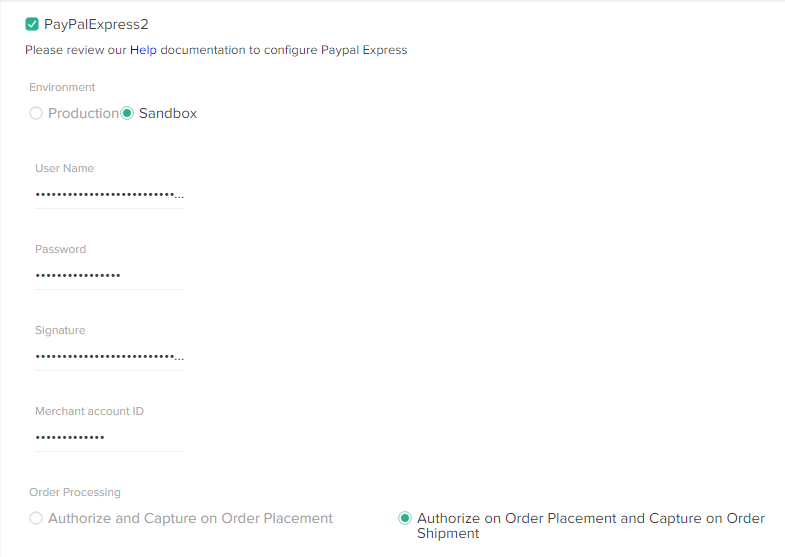
- Select the PayPal Environment you want to use:
- Select Sandbox to use PayPal's sandbox environment for testing your PayPal Express integration.
- Select Production to use a working PayPal environment that processes payments.
- Enter the User Name and Password for your PayPal merchant account.
- Enter your PayPal API Signature. To find your API signature in PayPal:
- Log in to paypal.com with your merchant account.
- Click Profile.

- On the My Profile page, select My Selling Tools.
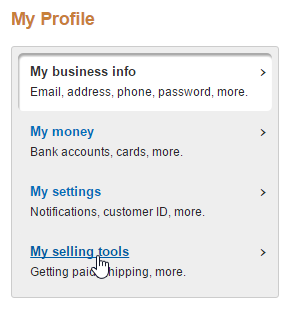
- In the Selling online section, locate API access and click Update.
- Click View API Signature under NVP/SOAP API integration.
- Enter your PayPal Merchant account ID. To find your ID:
- Log in to paypal.com with your merchant account.
- Click Profile.
- On the My Profile page, select My Business Info.
- Your Merchant account ID appears near the bottom of the list.
- Select an Order Processing method:
- Authorize and Capture on Order Placement both authorizes AND captures payment when an order is placed.
- Authorize on Order Placement and Capture on Order Shipment authorizes a payment when an order is placed, but does not capture that payment until you manually click Capture from the Orders module in Admin. (Typically, you capture payment when you ship an order.)
- Click Save to save your PayPal Express settings.
Display Billing Address
You can configure the PayPal Express application to display shoppers' billing address within Admin, on the checkout page, and in confirmation emails.
You can configure this functionality using the API Extensions JSON editor available in Admin. Refer to Getting Started with API Extensions for more information about API Extensions.
To configure the application to display shoppers' billing address:
- Make sure you have the latest version of the application installed.
- In Admin, go to System > API Extensions.
- Within the
paypalProcessorfunction configuration, setaddBillingInfototrue. You can also use themissingLastNameValueto provide a value for the last name in case it is missing from the billing info.
For example, if you chose to enable adding the billing info from Paypal, the configuration for thepaypalProcessorfunction would look like:{ "actionId": "http.storefront.routes", "contexts": [ { "customFunctions": [ { "applicationKey": "a0842dd.mppea.1.2.2.Release", "functionId": "paypalProcessor", "enabled": true, "configuration": { "addBillingInfo": true, "missingLastNameValue": "N/A" }, "timeoutMilliseconds": 30000 } ] } ] }
Enable the App
After configuration, enable the PayPal Express application to apply its functionality to your tenant:
- In Admin, go to System > Customization > Applications.
- Select the PayPal Express Application.
- Click Enable App on the app page.
Use the App
After you have installed the app and merged the theme changes, Check out with PayPal appears on the cart and checkout pages of your eCommerce site.
Pay with PayPal from the Cart Page
With PayPal Express enabled, your customers see a PayPal button from the Cart page of your site. Complete the following steps to test the user experience:
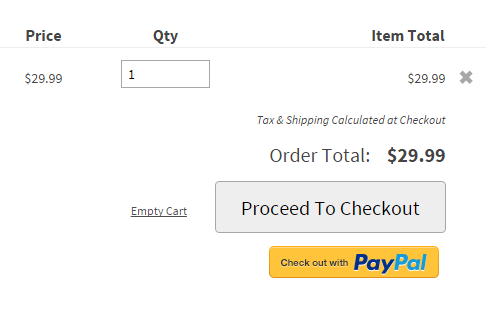
- Click Checkout with PayPal to launch a modal browser window for PayPal.
- Create or log in to your PayPal account. Because you are testing the buyer's experience, this should be a different account than your merchant account. You can also choose to remember your account info so you can skip the log-in process for future purchases.
- Select your preferred payment method and shipping address from the options saved in your PayPal account.
If you have a balance or credit in your PayPal account, PayPal requires you to use all of the balance before it allows you to select a different payment method.
- Click Continue to return to the eCommerce Checkout page. The shipping information from PayPal appears in eCommerce, and a PayPal logo appears in the Payment Information section.
- (Optional) Apply coupons or make changes. You can change any of the information on the Checkout page up until the time you click Place Order. Kibo automatically updates PayPal with any changes made through the Checkout page before the order is placed.
- Click Place Order. Kibo adds any shipping, fees, and taxes to the total charged to your PayPal account, and removes any amount covered by discounts or gift cards.
Pay with PayPal from the Checkout Page
A customer who chooses Proceed To Checkout from the Cart page can still check out with PayPal. Complete the following steps to test the user experience:
- On the Checkout page, enter your Shipping Information and select your Shipping Method.
- (Optional) Apply any coupons, gift cards, or store credits.
- Under Payment Information click Check out with PayPal:
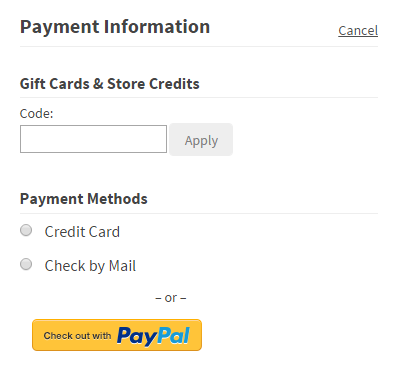 Sample Checkout page as it appears to a customer.
Sample Checkout page as it appears to a customer. - In the browser window that appears, log in to your PayPal account. Because you are testing the buyer's experience, this should be a different account than your merchant account. Kibo automatically sends the shipping address you entered to PayPal, and the full order amount (including shipping, taxes, and discounts) is reflected in the order total.
- Select your preferred payment method.
- Click Continue to return to the eCommerce Checkout page.
- Click Place Order to complete the order.
Payment Authorization and Capture
Depending on the Order Processing method you chose when you configured the app, when a customer clicks Place Order on a eCommerce Checkout page, eCommerce either just authorizes the order or authorizes the order AND captures payment.
Regardless of when you capture payment, Kibo strongly recommends you always capture payment from eCommerce. If you capture payment from your PayPal merchant account, you must then handle any refunds or returns from PayPal, which can throw off your eCommerce order history.
The order appears in the Orders module in Admin. Note the following details from the Payments tab:
 A sample PayPal Express order in Kibo eCommerce.
A sample PayPal Express order in Kibo eCommerce.
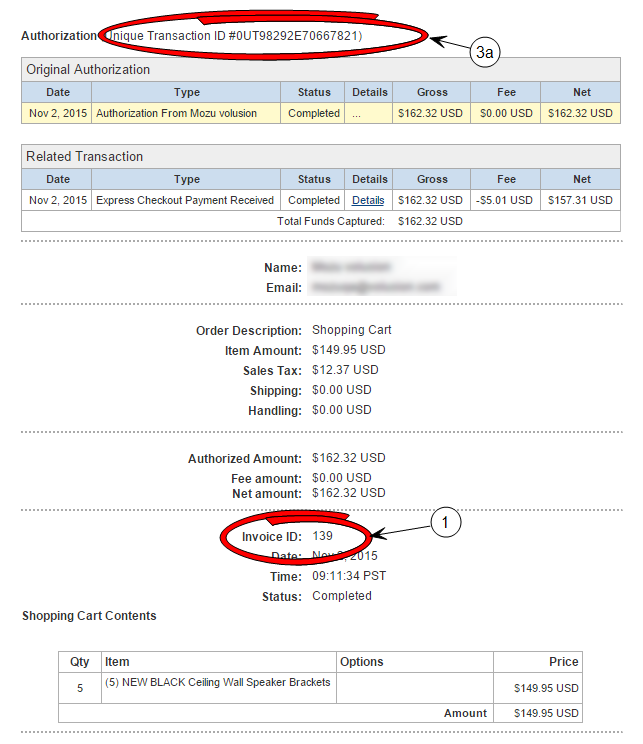 The Transaction Details page for the payment authorization from the same order in PayPal.
The Transaction Details page for the payment authorization from the same order in PayPal.
| Caption | Description |
|---|---|
| 1 | The Order Number in eCommerce matches the Invoice ID in PayPal. |
| 2 | The payment Method indicates a payment type of PayPal Express. |
| 3 | The Transaction History entry for the payment authorization:
|
| 4 | The Transaction History entry for the payment authorization.
|
Returns
If you return or credit a payment in eCommerce, the credit appears as a PayPal credit in the customer's PayPal account.
Declines
The PayPal Express Application does not process declines. If you decline a payment in eCommerce, you must also manually decline the payment in PayPal.